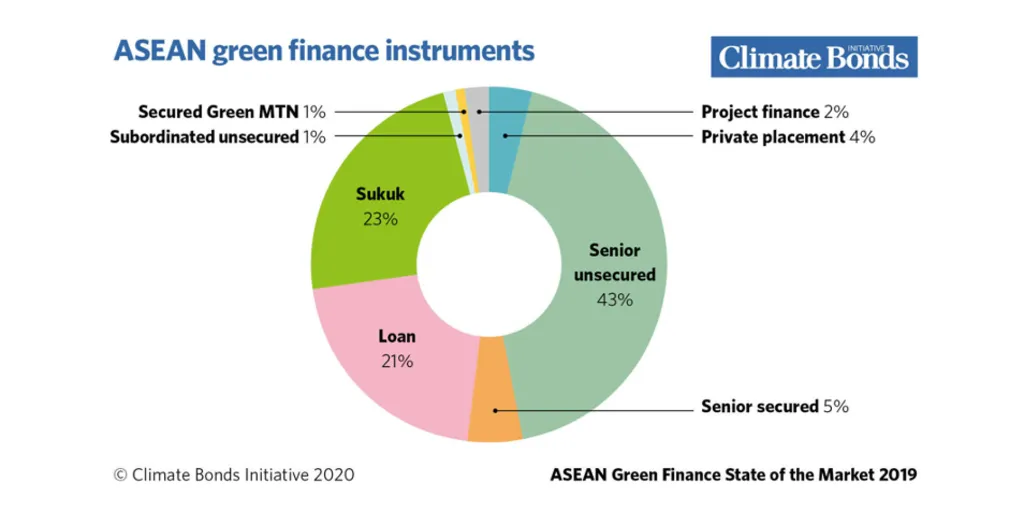Southeast Asia stands at a critical turning point. The region needs USD 210 billion every year to build climate-resilient infrastructure and support a sustainable green transition. This is where Southeast Asia green finance comes in. And not just as a funding tool, but as a cornerstone of the region’s climate and economic strategy.
While the numbers are large, so are the opportunities. By prioritizing green solutions, Southeast Asia could create up to 900,000 jobs and add USD 120 billion in economic value by 2030. This transformation could also boost GDP by 2%, proving that environmental progress and economic growth can go hand in hand.

Momentum Is Building, But Gaps Remain in Southeast Asia Green Finance
Green finance across the region is gaining traction. Private green investments in six key ASEAN countries surged 43% in 2024, reaching USD 8 billion. International investment in clean energy is also rising, growing at 15% annually since 2020, and totaling USD 43 billion in 2022.
Yet, a major financing gap of more than USD 50 billion remains. Small project sizes, regulatory delays, and poor alignment between investors and available projects hold back faster progress. Despite growing global green bond issuance (USD 487.1 billion in 2022) many Southeast Asian initiatives still struggle to secure funding at scale.
Read Also: Why Infrastructure Investment Opportunities Are Surging in SE Asia
Regional Partnerships Are Key
Collaboration is critical to unlocking Southeast Asia’s green potential. Countries like China, Japan, and South Korea are major public investors in ASEAN clean energy. Between 2013 and 2023, China invested over USD 2.7 billion, followed by Japan with USD 2.45 billion, and South Korea at USD 583 million.
Institutions like the Asian Development Bank (ADB) are also playing a vital role. Through its Green Finance Hub, ADB helps leverage USD 5–6 of private capital for every USD 1 of sovereign funding, bridging the financing gap and encouraging large-scale private sector participation.
Local Innovations in Southeast Asia Green Finance
Beyond international partnerships, Southeast Asia is seeing promising local innovations in green finance. Singapore's Green Bonds Programme has raised over S$4.6 billion since 2022, funding projects like solar-powered public housing and electric vehicle charging networks. Meanwhile, Thailand's Bio-Circular-Green (BCG) Economy Model has attracted $1.2 billion in sustainable investments, particularly in agritech and renewable energy.
In Vietnam, the Just Energy Transition Partnership (JETP) secured $15.5 billion to phase out coal, with a focus on community-based renewable projects. Similarly, Indonesia's carbon exchange, launched in 2023, has already facilitated $2.8 million in carbon credit trades, incentivizing forest conservation and clean energy.
A System-Based Approach to Climate Finance
To make meaningful progress, Southeast Asia must take a systems-based approach. This means aligning finance with emissions reduction targets, infrastructure needs, and social goals. Experts believe such an approach could cut 50% of the region’s emissions gap by 2030, while stimulating green industries, from clean energy to sustainable transport.
At the same time, governments must address regulatory bottlenecks and encourage innovative financial mechanisms. Simplified project approval, blended finance, and regional green taxonomies could unlock more capital and accelerate sustainable development.
Read Also: Green Infrastructure Southeast Asia is a Transformative Path
Southeast Asia Green Finance: Turning Potential Into Progress
Southeast Asia green finance is more than a climate solution, but a path to long-term prosperity. With rising investor interest, growing partnerships, and policy alignment, the region has the tools it needs to act. The stakes are high. Yet, with coordinated efforts and bold investments, Southeast Asia can turn ambition into action by building a resilient, inclusive, and green future for all.







